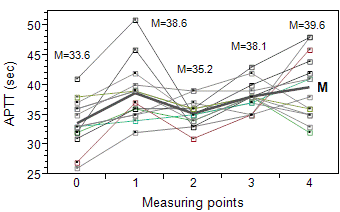Abstract
Background: Patients (pts) with multiple myeloma (MM) have an increased risk of thrombosis. Previous studies have shown that 3.7–4.6% of pts undergoing peripheral blood stem cell (PBSC) mobilization developed thrombotic complications.
Aims: The aim of the study was to investigate the blood coagulation status in MM pts during PBSC mobilization.
Methods: 20 pts: 12 males, 8 females at the age of 27 – 64 years (median 53) were included in the study. After bortezomib-containig induction therapy 5 of them achieved CR, 11 – VGPR and 6 – PR. PBSC mobilization was performed by using cyclophosphamide (CY, 4g/m2) and granulocyte colony-stimulating factor (G-CSF, 5mcg/kg/day). A central venous catheter (CVC) was placed on the day before CY administration and heparin-sulphate continuous infusion (500 IU/hour) as thromboprophylaxis was started. Subcutaneous injections of G-CSF were administrated when WBS decreased less 1 x 109/l. The procedures of stem cell collection were carried out when the number PB CD 34+ cells exceeded 10 x 103/ml. Hemostasis analysis was performed 5 times, namely before (point 0) and 24 hours after heparin administration (point 1), the next day after CY infusion (point 2), before G-CSF administration (point 3) and on the day of PBSC collection (point 4). Condition of hemostasis was assessed by the results of activated partial thromboplasin time (APTT, normal rate: 25 – 38 sec) and thrombin generation test, namely by using endogenous thrombin potential (ETP, normal rate: 760 – 1450 nM*min) in every point.
Hypercoagulation was considered in cases when APTT < 25 sec and ETP > 1450 nM*min. And hypocoagulation was estimated by data APTT > 38 sec and ETP < 760 nM*min. Time series analysis performed using TIMESERIES procedure in SAS 9.3 (SAS Institute Inc. Cary, NC). Significance level of alpha was set at 0.05.
Results: Before heparin administration (point 0) APTT evaluation showed normal coagulation in 18 pts (90%) and hypocoagulation in 2 pts (mean 34 sec, 95% CI 32 – 36 sec) (Figure 1). ETP was normal in 14 pts and increased in 6 cases (mean 1441 nM*min, 95% CI 1304 – 1578 nM*min) (Figure 2). Pts in CR demonstrated no significant difference in coagulation status compared to pts in VGPR or PR. On the next day after CVC incorporation and starting thromboprophylaxis (point 1), APTT and ETP have significantly changed (p < 0,05) to hypocoagulability in response to heparin infusion: mean data APTT became 38 sec (95% CI 36 – 41 sec) and mean ETP - 938 nM*min (95% CI 801 – 1074 nM*min). On the next day after CY administration (point 2) APTT was statistically significantly decreased (p < 0.05) reaching 35 sec (95% CI 34 – 36 sec). ETP had also changed but to a lesser degree, the mean was 1079 nM*min (95% CI 929 – 1229 nM*min). Hemostasis at point 3 was characterized by APTT mean 38 sec (95% CI 37 – 40 sec) and ETP mean 1057 nM*min (95% CI 911 – 1203 nM * min). On the day of PBSC collection mean values of measured parameters have not changed as compared to the previous point: APTT was 40 sec (95% CI 37 – 43 sec) and ETP was 1046 nM*min (95% CI 916 – 1176 nM*min) (Table 1).
Thrombotic events were diagnosed in 2 cases of the total of 20 pts. There were two females, 54 and 56 years, both in CR MM. The first pt developed CVC-associated thrombosis. She had additional risk factors such as obesity (BMI – 44) and heterozygous MTHFR polymorphism. The second pt demonstrated acute violation of cerebral circulation which arose due to occlusion of the right internal carotid artery. She was a hard smoker and heterozygous FV Leiden polymorphism. Having confirmed thrombotic complications, the dose of heparin had been increased. Besides, folic acid was administrated for the first pt and combination of aspirin and pentoxifilline for the second. PBSC collection was successful for both pts.
Summary: The results of our study identify latent hypercoagulation status in 30% pts of confirmed by elevated ETP. Those changes were registered despite of achievement CR or PR MM. Thrombotic complications have developed in 10% from our group. Notably, one should consider individual risk factors for each pt.
Measurements data of parameters of hemostasis
| Measuring point . | Mean APTT (95% CI) . | Mean ETP (95% CI) . |
|---|---|---|
| 0 | 33.6 (31.2-35.9)* | 1441.1 (1304.3-1577.9)* |
| 1 | 38.6 (35.7-41.6)* | 937.6 (801.3-1074.0)* |
| 2 | 35.2 (33.9-36.5)* | 1079.0 (928.8-1229.2)* |
| 3 | 38.1 (36.7-39.5) | 1057.2 (911.4-1203.1) |
| 4 | 39.6 (36.5-42.8) | 1046.2 (916.0-1176.3) |
| * Means in the same column are significantly different (P<0.05) | ||
| Measuring point . | Mean APTT (95% CI) . | Mean ETP (95% CI) . |
|---|---|---|
| 0 | 33.6 (31.2-35.9)* | 1441.1 (1304.3-1577.9)* |
| 1 | 38.6 (35.7-41.6)* | 937.6 (801.3-1074.0)* |
| 2 | 35.2 (33.9-36.5)* | 1079.0 (928.8-1229.2)* |
| 3 | 38.1 (36.7-39.5) | 1057.2 (911.4-1203.1) |
| 4 | 39.6 (36.5-42.8) | 1046.2 (916.0-1176.3) |
| * Means in the same column are significantly different (P<0.05) | ||
No relevant conflicts of interest to declare.
Author notes
Asterisk with author names denotes non-ASH members.



